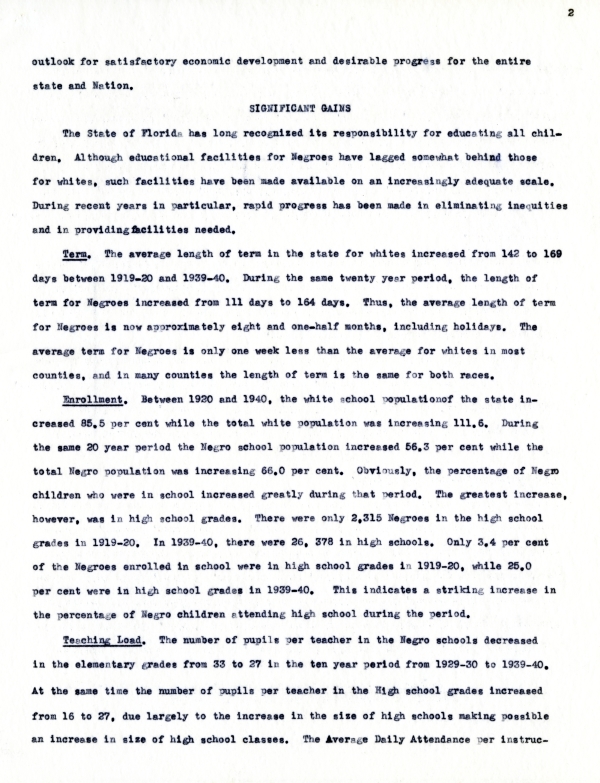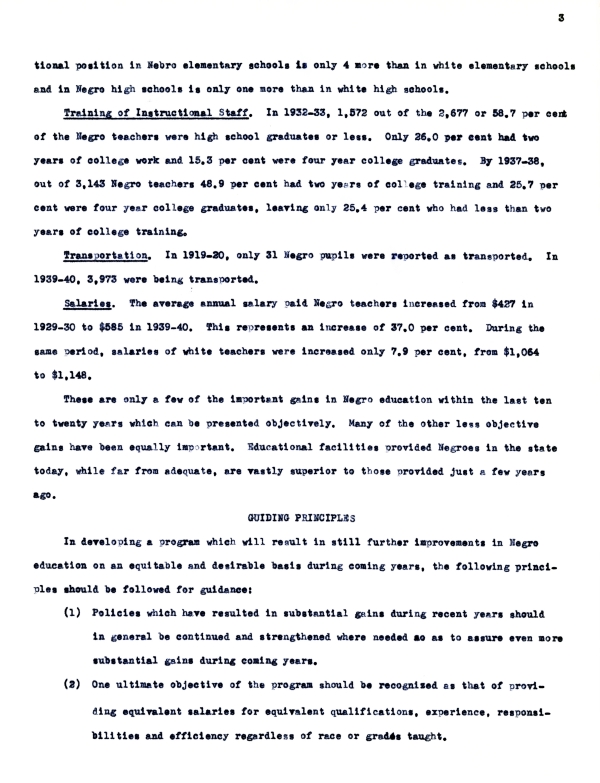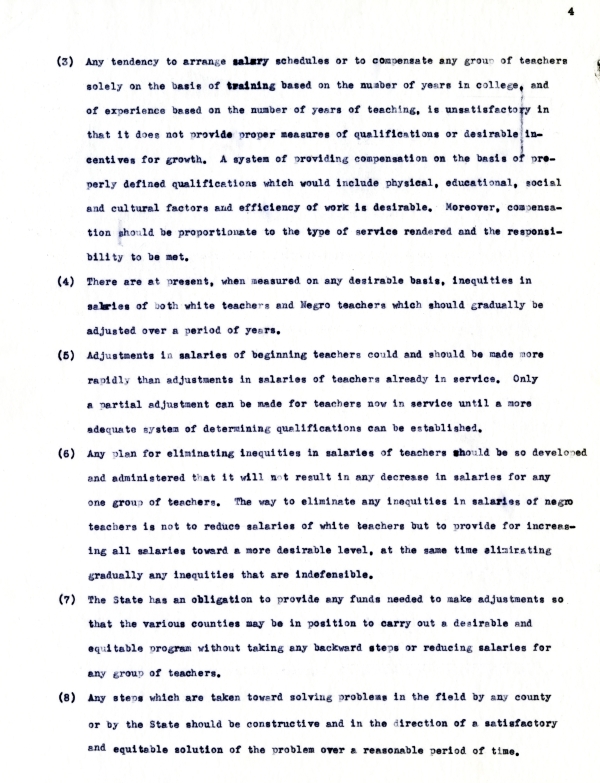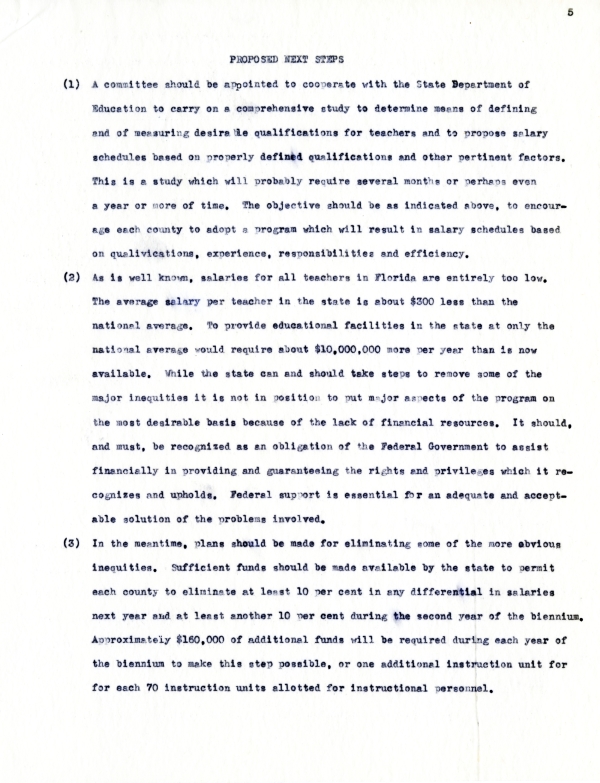Florida Memory is administered by the Florida Department of State, Division of Library and Information Services, Bureau of Archives and Records Management. The digitized records on Florida Memory come from the collections of the State Archives of Florida and the special collections of the State Library of Florida.

State Archives of Florida
- ArchivesFlorida.com
- State Archives Online Catalog
- ArchivesFlorida.com
- ArchivesFlorida.com
State Library of Florida
Related Sites
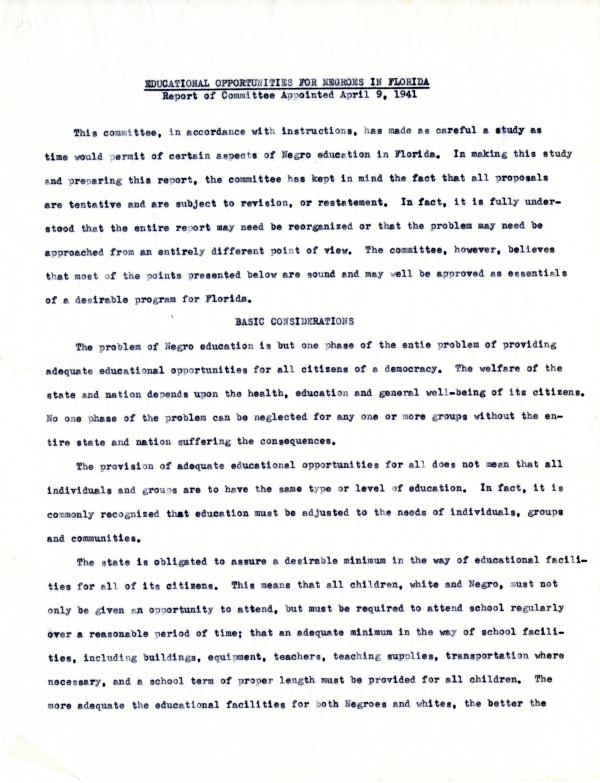
Description of previous item
Description of next item

Source
Description
Date
Creator
Format
Topic
Subjects
Geographic Term
EDUCATIONAL OPPORTUNITIES FOR NEGROES IN FLORIDA
Report of Committee Appointed April 9, 1941
This committee, in accordance with instructions, has made as careful a study as time would permit of certain aspects of Negro education in Florida. In making this study and preparing this report, the committee has kept in mind the fact that all proposals are tentative and are subject to revision, or restatement. In fact, it is fully understood that the entire report may need be reorganized or that the problem may need be approached from an entirely different point of view. The committee, however, believes that most of the points presented below are sound and may well be approved as essentials of a desirable program for Florida.
BASIC CONSIDERATIONS
The problem of Negro education is but one phase of the [entire] problem of providing adequate educational opportunities for all citizens of a democracy. The welfare of the state and nation depends upon the health, education and general well-being of its citizens. No one phase of the problem can be neglected for any one or more groups without the entire state and nation suffering the consequences.
The provision of adequate educational opportunities for all does not mean that all individuals and groups are to have the same type or level of education. In fact, it is commonly recognized that education must be adjusted to the needs of individuals, groups and communities.
The state is obligated to assure a desirable minimum in the way of educational facilities for all of its citizens. This means that all children, white and Negro, must not only be given an opportunity to attend, but must be required to attend school regularly over a reasonable period of time; that an adequate minimum in the way of school facilities, including buildings, equipment, teachers, teaching supplies, transportation where necessary, and a school term of proper length must be provided for all children. The more adequate the educational facilities for both Negroes and whites, the better the
Title
Subject
Description
Creator
Source
Date
Format
Language
Type
Identifier
Coverage
Geographic Term
Thumbnail
Display Date
ImageID
topic
Subject - Corporate
Transcript
EDUCATIONAL OPPORTUNITIES FOR NEGROES IN FLORIDA
Report of Committee Appointed April 9, 1941
This committee, in accordance with instructions, has made as careful a study as time would permit of certain aspects of Negro education in Florida. In making this study and preparing this report, the committee has kept in mind the fact that all proposals are tentative and are subject to revision, or restatement. In fact, it is fully understood that the entire report may need be reorganized or that the problem may need be approached from an entirely different point of view. The committee, however, believes that most of the points presented below are sound and may well be approved as essentials of a desirable program for Florida.
BASIC CONSIDERATIONS
The problem of Negro education is but one phase of the [entire] problem of providing adequate educational opportunities for all citizens of a democracy. The welfare of the state and nation depends upon the health, education and general well-being of its citizens. No one phase of the problem can be neglected for any one or more groups without the entire state and nation suffering the consequences.
The provision of adequate educational opportunities for all does not mean that all individuals and groups are to have the same type or level of education. In fact, it is commonly recognized that education must be adjusted to the needs of individuals, groups and communities.
The state is obligated to assure a desirable minimum in the way of educational facilities for all of its citizens. This means that all children, white and Negro, must not only be given an opportunity to attend, but must be required to attend school regularly over a reasonable period of time; that an adequate minimum in the way of school facilities, including buildings, equipment, teachers, teaching supplies, transportation where necessary, and a school term of proper length must be provided for all children. The more adequate the educational facilities for both Negroes and whites, the better the
2
outlook for satisfactory economic development and desirable progress for the entire state and nation.
SIGNIFICANT GAINS
The State of Florida has long recognized its responsibility for educating all children. Although educational facilities for Negroes have lagged somewhat behind those for whites, such facilities have been made available on an increasingly adequate scale. During recent years in particular, rapid progress has been made in eliminating inequities and in providing facilities needed.
Term. The average length of term in the state for whites increased from 142 to 169 days between 1919-20 and 1939-40. During the same twenty year period, the length of term for Negroes increased from 111 days to 164 days. Thus, the average length of term for Negroes is now approximately eight and one-half months, including holidays. The average term for Negroes is only one week less than the average term for whites in most counties, and in many counties the length of term is the same for both races.
Enrollment. Between 1920 and 1940, the white school [population of] the state increased 85.5 per cent while the total white population was increasing 111.6. During the same 20 year period the Negro school population increased 56.3 per cent while the total Negro school population was increasing 66.0 per cent. Obviously, the percentage of Negro children who were in school increased greatly during that period. The greatest increase, however, was in high school grades. There were only 2,315 Negroes in the high school grades in 1919-20. In 1939-40, there were 26,378 in high schools. Only 3.4 per cent of the Negroes enrolled in school were in high school grades in 1919-20, while 25.0 per cent were in high school grades in 1939-40. This indicates a striking increase in the percentage of Negro children attending high school during the period.
Teaching Load. The number of pupils per teacher in the Negro schools decreased in the elementary grades from 33 to 27 in the ten year period from 1929-30 to 1939-40. At the same time the number of pupils per teacher in the High school grades increased from 16 to 27, due largely to the increase in the size of high schools making possible an increase in size of high school classes. The Average Daily Attendance per instruc-
3
tional position in the [Negro] elementary schools is only 4 more than in white elementary schools and in Negro high schools is only one more than in white high schools.
Training of Instructional Staff. in 1932-33, 1,572 out of the 2,677 or 38.7 per cent of the Negro teachers were high school graduates or less. Only 26.0 per cent had two years of college work and 15.3 per cent were four year college graduates. By 1937-38, over 3,143 Negro teachers 48.9 per cent had two years of college training and 25.7 per cent were four college graduates, leaving only 25.4 per cent who had less than two years of college training.
Transportation. In 1919-20, only 31 Negro pupils were reported as transported. In 1939-40, 3,973 were being transported.
Salaries. The average annual salary paid Negro teachers increased from $427 in 1929-30 to $585 in 1939-40. This represents an increase of 37.0 per cent. During the same period, salaries of white teachers were increased only 7.9 per cent, from $1,064 to $1,148.
These are only a few of the important gains in Negro education within the last ten to twenty years which can be presented objectively. Many of the other less objective gains have been equally important. Educational facilities provided Negroes in the state today, while far from adequate, are vastly superior to those provided just a few years ago.
GUIDING PRINCIPLES
In developing a program which will result in still further improvements in Negro education on an equitable and desirable basis during coming years, the following principles should be followed for guidance:
(1) Policies which have resulted in substantial gains during recent years should in general be continued and strengthened where needed so as to assure even more substantial gains during coming years.
(2) One ultimate objective of the program should be recognised as that of providing equivalent salaries for equivalent qualifications, experience, responsibilities and efficiency regardless of race or grades taught.
4
(3) Any tendency to arrange salary schedules or to compensate any group of teachers solely on the basis of training based on the number of years in college, and of experience based on the number of years of teaching, is unsatisfactory in that it does not provide proper measures of qualifications or desirable incentives for growth. A system of providing compensation on the basis of properly defined qualifications which would [include] physical, educational, social and cultural factors and efficiency of work is desirable. Moreover, compensation should be proportionate to the type of service rendered and the responsibility to be met.
(4) There are at present, when measured on any desirable basis, inequities in salaries of both white teachers and Negro teachers which should gradually be adjusted over a period of years.
(5) Adjustments in salaries of beginning teachers could and should be made more rapidly than adjustments in salaries of teachers already in service. Only a partial adjustment can be made for teachers now in service until a more adequate system of determining qualifications can be established.
(6) Any plan for eliminating inequities in salaries of teachers should be so developed and administered that it will not result in any decrease in salaries for any one group of teachers. The way to eliminate any inequities in salaries of negro teachers is not to reduce salaries of white teachers but to provide for increasing all salaries toward a more desirable level, at the time eliminating gradually any inequities that are indefensible.
(7) The State has an obligation to provide any funds needed to make adjustments so that the various counties may be in position to carry out a desirable and equitable program without taking any backward steps or reducing salaries for any group of teachers.
(8) Any steps which are taken toward solving problems in the field by any county or by the State should be constructive and in the direction of a satisfactory and equitable solution of the problem over a reasonable period of time.
5
PROPOSED NEXT STEPS
(1) A committee should be appointed to cooperate with the State Department of Education to carry on a comprehensive study to determine means of defining and of measuring desirable qualifications and other pertinent factors. This is a study which will probably require several months or perhaps even a year or more of time. The objective should be as indicated above, to encourage each county to adopt a program which will result in salary schedules based on [qualifications], experience, responsibilities, and efficiency.
(2) As is well known, salaries for all teachers in Florida are entirely too low. The average salary per teacher in the state is about $300 less than the national average. To provide educational facilities in the state at only the national average would require about $10,000,000 more per year than is now available. While the state can and should take steps to remove some of the major inequities it is not in position to put major aspects of the program on the most desirable basis because of the lack of financial resources. It should, and must, be recognized as an obligation of the Federal Government to assist financially in providing and guaranteeing the rights and privileges which it recognizes and upholds. Federal support is essential for an adequate and acceptable solution of the problems involved.
(3) In the meantime, plans should be made for eliminating some of the more obvious inequities. Sufficient funds should be available by the state to permit each county to eliminate at least 10 per cent in any differential in salaries next year and at least another 10 per cent during the second year of the biennium. Approximately $160,000 of additional funds will be required during each year of the biennium to make this step possible, or one additional instruction unit for each 70 instruction units allotted for instructional personnel.
6
(4) A continuing study should be carried on during the biennium to determine to what extent inequities are eliminated by these adjustments and can be eliminated by other adjustments in bases for salary schedules. The program for years beyond this biennium should then be developed on the basis of findings growing out of these studies.
Chicago Manual of Style
Florida Education Association. Report on the Educational Opportunities for Negroes in Florida, 1941. 1941 (circa). State Archives of Florida, Florida Memory. <https://www.floridamemory.com/items/show/329093>, accessed 28 December 2025.
MLA
Florida Education Association. Report on the Educational Opportunities for Negroes in Florida, 1941. 1941 (circa). State Archives of Florida, Florida Memory. Accessed 28 Dec. 2025.<https://www.floridamemory.com/items/show/329093>
AP Style Photo Citation
(State Archives of Florida/Florida Education Association)

 Listen: The Assorted Selections Program
Listen: The Assorted Selections Program